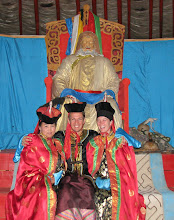Blackfoot
Blackfoot

The Blackfoot, whose name literally means "moccasins which became black from prairie ash," are a plains tribe who frequented the border area of northern Montana and southern Alberta, Canada. They are not to be confused with the Blackfeet, a similar name and one of the seven bands of the Lakota (Sioux).
The Blackfoot lived among the Rocky Mountains, often wintering along the banks of the Flathead River so they could hunt deer, elk, moose, antelope and bear. Like most nomadic, buffalo-hunting tribes they summered on the Great Plains, living in circles of very large and distinct tipis with lodgepoles that cleared the top of the buffalo hide covers by four to six feet. The center of the tipi circle was often the site of ceremony and hunting strategy sessions.
The summer hunt often found warriors "disguised" as animals in hides and fur so the buffalo could not detect their human scent. The buffalo were often driven into small, enclosed areas where they would be easier to kill. Sometimes "buffalo jumps" were used, before and after the introduction of the horse. Buffalo would be driven off a cliff easy enough to negotiate but high enough that the fall would kill them.
The buffalo provided the Blackfoot, too, with clothing, shelter, tools and weapons. After the hunt, the women of the tribe would dry and preserve the meat, often making pemmican (dried meat, fat and berries) that could be traded to area trappers. The women and children also scoured the woods and plains for berries, nuts and other wild foods to supplement the diet.
The men wore long buckskin leggings that pulled up to the waist and folded over a belt, creating the look of a breechcloth. Women wore long buckskin dresses that were sleeveless in summer and had sleeves to add in winter. Buffalo robes and moccasins with the buffalo fur side in for warmth rounded out the winter wardrobe.
The Blackfoot were gifted artists, with many tipis painted with exquisite designs and ceremonial clothing that was fringed and decorated with quillwork, beads and paint.
Blackfoot belief is that an old man named Napi was the creator of the world. The tribe participated in an annual Sundance ceremony and many special religious and brotherhood societies existed. Women, too, participated in all-female societies.
While the Blackfoot were forced to protect their homelands from white intruders too, they did carry on trade peacefully with European trappers for more than 200 years. Over the course of time, many Blackfoot died from disease brought by whites and by the late 1800s hoards of white settlers and sightseers flooded Blackfoot lands. Thousands and thousands of buffalo were killed for sport not need, and then left to rot. The winter of 1883 saw the starvation death of more than 800 Blackfoot because there were already no more buffalo. Those who survived gave up their lands and submitted to removal to reservations in Canada and Montana in exchange for government subsidies of cattle, money and supplies.
Today, many Blackfoot are successful cattle ranchers and farmers still living on reservations in Montana and Alberta, Canada.


0 Comments:
Post a Comment
Subscribe to Post Comments [Atom]
<< Home